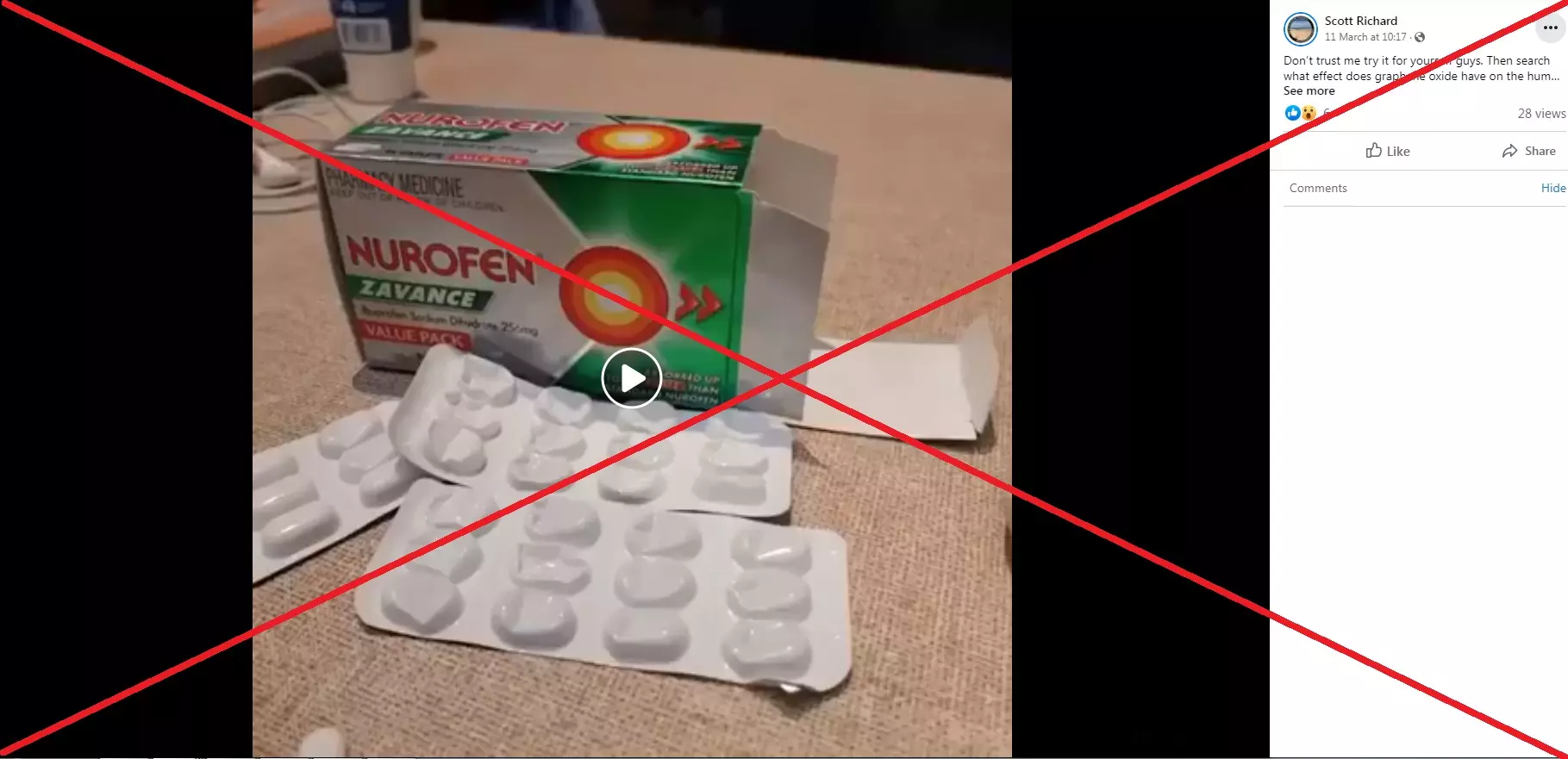Videos showing black particles swirling about in a glass of dissolved Nurofen tablets have been shared in a string of social media posts claiming they are graphene oxide. However, the claim is false. The pain relief medication's manufacturer said the particles are black iron oxide, which health authorities and experts say is widely used as a colouring agent in the pharmaceutical industry and is safe for consumption.
"Don't trust me, try it for yourself, guys. Then search what effect does graphene oxide have on the human body," reads a Facebook post from March 11.
The video shows a woman dissolving Nurofen Zavance tablets in a glass of water and then placing a magnet on the side of the glass, which attracts black particles in the solution.
"The black on Nurofen tablets that we think is ink is actually graphene oxide," she says.
"Can you imagine, this is just a week's worth, if you've been taking Nurofen for a year, how much of this stuff is in your system? We really need to start looking at things and not just trusting."
 A screenshot of the video posted to Facebook taken on March 24, 2022.
A screenshot of the video posted to Facebook taken on March 24, 2022. Graphene is one of the world's strongest and lightest materials, with promising applications for greener energy and nanomedicine.
It has been the focus of a wave of disinformation, particularly around Covid-19 vaccines, with conspiracy theorists claiming it is inserted into the jabs to "magnetise" and "control" people.
None of the Covid-19 vaccines approved for use by the World Health Organization contain graphene or its derivative, graphene oxide.
Videos of social media users filming themselves purportedly showing graphene oxide in Nurofen tablets have appeared on multiple sites, including Facebook, YouTube, Telegram, Rumble and BitChute.
AFP replicated the experiment seen in social media posts and found that a magnet placed on the side of the glass did indeed attract black particles in the solution.
However, the substance is not graphene oxide.
'No graphene' in Nurofen
A representative for Nurofen's manufacturer, Reckitt Benckiser said the black particles were a dyeing agent called black iron oxide.
"The ink used on Nurofen tablets is compliant with regulatory requirements. It contains the ingredient Black Iron Oxide, which is used widely within the pharmaceutical industry and is safe for human consumption," the spokesperson told AFP.
"The ink does not contain graphene or any similar substances."
Graphene and graphic oxide are not listed as ingredients in any of the 24 Nurofen medicines approved by the Australian Register of Therapeutic Goods (ARTG).
Some of the medicines, including the tablets seen in the video, Nurofen Zavance, do feature "iron oxide black" as an ingredient.
Dusan Losic, director of the Australian Research Council's Graphene Research Hub, said that while graphene oxide can be used as a carrier for drug molecules, it was "not something you would expect" to have in Nurofen tablets.
He said tiny graphene oxide particles could be seen by the naked eye if there was a big enough group of them, but they would have a "slightly yellow to brown colour" when dispersed in water, not black as seen in the video.
Colouring agent
The Australian Therapeutic Goods Administration (TGA), which oversees the safety and efficacy of medicines in Australia, said black iron oxide -- also called iron oxide black -- in Nurofen tablets was safe for human consumption.
"Iron oxide black is typically used as a colouring pigment in printing inks on capsules and tablets. It is permitted for use as a colouring substance in medicines for oral use provided it meets quality and quantity requirements," a spokesperson told AFP.
"The iron oxide black present in Nurofen Zavance meets these requirements."
The TGA's specifications for the use of black iron oxide and other colourings used in medicines is available on its website.
Mathew Martin-Iverson, a pharmacologist at the University of Western Australia said black iron oxide was also used as a colouring agent in food.
"Iron oxide is widely used as a colouring agent in some foods such as sweets, olives or cheese rind and is approved for that use and has the name E172 as an additive in Europe," he told AFP.
(Except for the headline, this story has not been edited by BOOM staff and is published from a syndicated feed.)